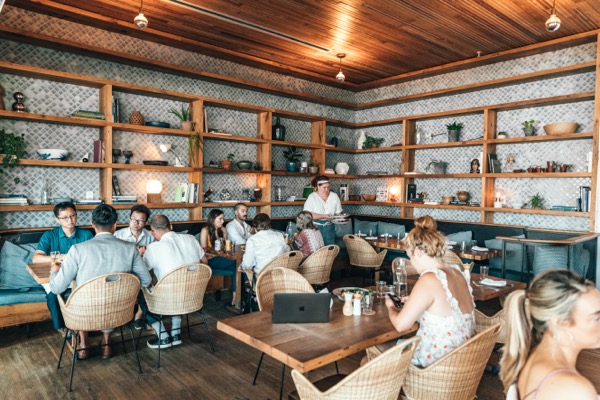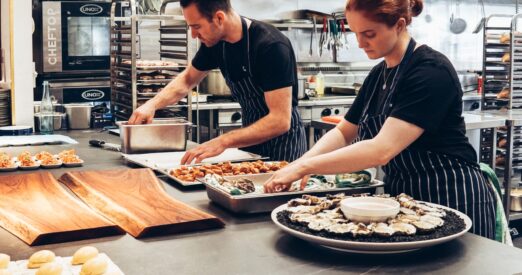
5 Tips To Control and Conquer Fluctuating Restaurant Costs
by The Ottimate Editorial Team
Embarking on a restaurant venture is a significant financial commitment. As per Sage’s research, considering restaurant fixed costs, the average amount to open a restaurant in a leased building is around $275,000. If ownership of the property is the goal, the expense exceeds $400,000.
As every operator learns very quickly, this large chunk of change is just a ticket into the game. It doesn’t come close to accounting for other costs that pile up when the restaurant actually opens its doors. Restaurant owners have a host of expenses to plan for and manage, causing the price of investment to continue to rise.
Plenty of operators have been able to conquer this mountain of money by implementing guardrails for restaurant costs so that hard-earned profits stay protected. Keep reading to learn about restaurant costs, the two types of them that operators need to plan for, and how to better control unexpected spend.
What Are Restaurant Costs?
Restaurant costs are all of the expenses an operator can expect to spend on operating their business. It’s anything from rent, utilities, and insurance to food, linens, and labor.
There are two types of restaurant costs that operators need to know about: fixed and fluctuating.
What’s the Difference Between Fixed and Fluctuating Restaurant Costs?
Fixed restaurant costs are recurring expenses at a predetermined rate. Rent, insurance, membership or software fees, and salaried employees are all examples of fixed restaurant costs. It’s easy for operators to budget for fixed restaurant costs because you know exactly what to expect on any given week, month, or year.
Fluctuating restaurant costs are harder to nail down — both the frequency and the total costs can vary widely. Labor and food costs are the largest fluctuating restaurant costs that operators should plan for. Consider an upscale, sit-down restaurant in a hip neighborhood: a Tuesday lunch shift is going to require a lot less waitstaff than a Saturday night dinner rush. That means the labor cost between just two shifts will have a large gap between them.
The key difference between fixed and fluctuating restaurant costs is that fixed costs are rigid, so restaurant owners and operators must better control fluctuating costs if they want to reduce overall spend.

How Do Operators Closely Control Fluctuating Restaurant Costs?
People in the hospitality industry know that anything can happen during any given shift. It’s important to take this same mentality into controlling fluctuating restaurant costs: when operators expect the unexpected in their budgets, they can be better prepared to tackle pricing peaks as they come.
Here are five ways that restaurant owners and operators can control and conquer fluctuating restaurant costs:
Invest in Labor Wisely
It’s no secret that hiring in hospitality has become much more difficult in the post-pandemic world. A recent report from One Fair Wage found that 76% of restaurant workers left their positions due to the low wages and tips.
Controlling labor spend doesn’t necessarily mean you should cut staff — especially at a time when good people are hard to find. In fact, you should consider reinvesting in your people with fixed salaries that you can easily budget for. The same report stated that 78% of hospitality workers would stay in their jobs if they were given the opportunity to earn a living wage.
A wise investment in labor doesn’t mean that every single person you employ should become salaried. Instead, think about the roles that are absolutely vital to the overall success of the restaurant, which roles may need to stay hourly, and what can be replaced with another solution.
Think about invoice processing. We’ve estimated before that the price to process just one invoice is $21.25—and the number of invoices received by a restaurant fluctuates on a daily basis. By replacing human invoice processing with invoice management software, you’re trading an expensive, fluctuating labor cost with a fixed software subscription price.

Have an Expense Policy
You can reduce and control how much you spend on labor, but what about reducing and controlling how much your employees are spending on items for the restaurant?
Expense policies, however corporate they may sound, can help you reserve your petty cash. If you limit the number of employees who are able to make spur-of-the-moment spending decisions, then further limit how much is actually available for them to spend, you’re more closely controlling a fluctuating cost.
Of course, this is easier said than done with cash. You can get even more control over employee spending with the spend management solution of virtual cards. Virtual cards connect back to your bank accounts and offer you the opportunity to assign them only to specific users and uses. They even open the opportunity for one-time payments. This eliminates the risk of theft all while enabling you to keep a watchful eye on who is spending what, where.
Improve Vendor Relationships
Obviously food is pretty important to every restaurant. But with food prices changing frequently, food costs can easily skyrocket without proper preparations for these fluctuating expenses. One of the ways you can better control food-related expenses is to engage with your vendors.
Food prices vary due to seasonality and demand, but they can also vary depending on the vendor. Establishing a professional, respectful relationship with each of your vendors can put you in a better situation to negotiate fixed prices on the food you order the most, without being held hostage to the volatility of the market.
Strong working relationships call for accountability. If you’ve noticed that the price you’re paying for carrots, as an example, has steadily increased by a few cents from week to week, it’s worth mentioning to your vendor. Just as your vendors expect restaurants to be honest and pay them on time, restaurants should also ask for honesty with vendors when it comes to pricing. Software-driven insights can help restaurant operators keep a close eye on those price changes and even alert vendors when prices go beyond existing agreements.
Get Flexible With Menu Items
No matter how engaged businesses may be with their vendors, sometimes the demands of the market are just too strong. In May 2021, the price of corn has risen by 50% in just a year. This not only has major implications for summer cookouts, but also for animal feed. And if it’s more expensive for the stockyard to feed the animals, those expenses will be passed onto consumers, creating an even smaller margin on your meat-based menu items.
Kitchens are creative. So when food prices get too high to justify, why not make some adjustments on the menu? If the price of meat skyrockets, play with vegetarian or vegan recipes and add your favorites to the menu. It doesn’t mean that you’re now a vegan restaurant — it just means you’re adapting to the moment.
Take a similar approach with low-cost, seasonal produce to add high-margin specials to your menu. You can drive demand for the items by marketing them as limited-time offers, then price them higher due to the anticipated demand.
Plan for Equipment To Fail
An often overlooked aspect of fluctuating restaurant costs is with equipment. Even if you have the best possible labor and food cost controls in place, all of those savings can be gone in an instant when an HVAC system fails or the walk-in won’t get cold.
Maintenance costs can be anywhere between 1.5-6% of a restaurant’s sales. Operators should have at least some money set aside to anticipate equipment failures so profits aren’t wiped out by emergency repairs. But implementing preventative maintenance for things like refrigeration, plumbing, and cooking equipment can help restaurant equipment run smoothly — and help avoid the frequency of major, expensive repairs.
Now that you’re ready to conquer fluctuating restaurant costs, explore the rest of Ottimate’s blogs for more advice on how to improve your restaurant operations.
Stay up to date on the latest news in AP automation and finance
Related

